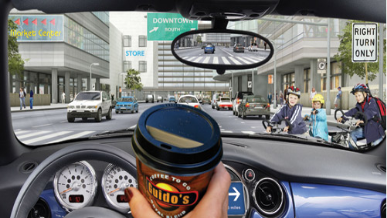See Near and Far After Cataract Surgery
During cataract surgery, the cloudy natural lens within the eye will be replaced with a clear artificial intraocular lens (IOL). Single-focus IOLs used in the majority of cataract patients result in predictably good distance vision without glasses but need the use of reading glasses or cheaters. The availability of new technology IOLs, and reliable monovision techniques may allow you to see both near objects and distant objects without the need for glasses, bifocals, or reading glasses.
When at rest, a normal eye is focused for distant objects (about 20 feet to infinity). To see objects closer than 20 feet, the eye needs to change focus. When young, the natural crystalline lens within the eye is able to change shape and thereby change focus easily and for a wide range of focus. This is called accommodation.
Presbyopia
At about age 10, the natural lens begins a very slow process of becoming less and less able to accommodate. This is called presbyopia. Presbyopia normally does not affect near vision until after age 40. This is when reading glasses or bifocals become necessary to see near objects. There is no “cure” for presbyopia.
As a cataract forms the lens becomes even less able to accommodate, however, most people who develop cataracts have been fully presbyopic for quite some time and have been using readers and bifocals for years.
Monofocal IOL
A monofocal IOL is an intraocular lens with a fixed focus for one distance. A cataract doctor may select monofocal IOLs that are for near focus, for mid-distance focus, or for distant focus. Only one of these three can be selected and the focus will not change after surgery.
Traditional cataract surgery provides focus of both eyes for distant objects and the patient uses reading glasses to see near objects. The vast majority of cataract patients elect to have monofocal IOLs in both eyes set for distance vision and then use reading glasses to see objects near.

After the implantation of a monofocal lens, the distance is clear but the intermediate zone such as the dashboard as well as the near zone such as the the writing on the coffee cup are out of focus After the implantation of a monofocal lens, the distance, the intermediate zone as well as the near zone are all in clear focus Methods to See Near and Far

There are three primary methods for a person to see near and distant after cataract surgery:
- Monovision
- Multifocal IOL implantation
- Accomodating IOL implantation
Monovision is a process of setting the focus of one eye for near objects and the focus of the other eye for distant objects. The brain then combines the two images. There is normally no extra charge for monovision correction.
Multifocal IOLs include the Tecnis Multifocal (TMF) and ReSTOR. IOLs The only accommodating IOL currently approved for the United States is the Crystalens. The TMF, ReSTOR, and Crystalens are collectively referred to as “premium IOLs”. There is almost always an extra charge for premium IOLs.
Everything is Compromise for Near and Far
Premium IOLs are a significant improvement on IOLs of only a few years ago, but not every type of IOL is best for every person. Monovision has been around for years, but not everyone can contend with its effect.
All methods to be able to see both near and far have a trade-off and none will restore vision to what it was when the patient was in his or her 20s. The probability of never needing corrective lenses for vision at all distances is relatively low, however, a reduced need for corrective lenses for a larger range of vision distances is reasonably probable.
Monovision
The concept of monovision is very simple. One eye is corrected for near vision and the other eye is corrected for distance vision. The brain decides which eye to use and when. The chief advantage of monovision is the freedom it can provide from reading glasses. Some people cannot stand the monovision effect of one eye for distant focus and one for near. About one-third of those who try monovision do not like it.
Monovision may cause a decrease of depth perception. A pair of distance glasses may be needed when superior depth perception is required, such as driving at night.
Blurred vision in the “near” eye may be noticed when looking at a distant object with the “distant” eye blocked, and visa-versa.
With both eyes open the patient may experience a blur effect and that can present as mild halos and provide less than sharp vision, however closing one eye or using full correction glasses will commonly eliminate this
Multifocal IOL
Multifocal IOLs are lenses that have rings of focus power variations. These lenses are designed like a bullseye target with different rings. Some rings provide focus for near objects, some for mid-range objects, and some rings provide the focusing power for distant objects. Because light is focused for near, mid-distance, and distant objects, multifocal IOLs can provide a full range of vision with a reduced need for corrective lenses.
Multifocal IOLs have some limitations too. The transition from one ring to the next can create blur that presents as halos around objects, especially light emitting objects and especially at night. Not all persons are bothered by this halo effect, but it is a consideration.
Ask about our cash discount.
If you would like to find out more about this exciting, once in a lifetime opportunity of turning back the clock on your vision, please contact us to see how we can restore your near vision to what it used to be when you were younger. Call us at 281-420-EYES(3937) or Schedule Online
